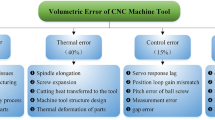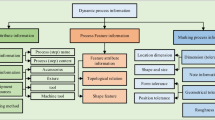Abstract
Today, machining of large, integral constructed structural parts requires expensive machining centers. In contrast, modern industrial robots are suitable for a wide field of applications and are characterized large working spaces and low capital investment. Therefore, they provide high economical potential for machining applications in aerospace industry, especially for the machining of near to shape pre-products like extruded profiles. However, their constructive characteristics like low stiffness and high sensitivity to vibrations lead to disadvantages compared with conventional machining centers and have to be considered during process planning. Therefore, several methods for offline and online optimization of robot machining processes were developed and integrated in a new process chain for manufacturing of structural fuselage parts. Thereby, the conventional CAD–CAM process planning chain was extended with simulation based analysis and optimization methods and a load-depending trajectory planning. These methods for offline process optimization within this novel process chain are presented in this paper.











Similar content being viewed by others
References
Uhlmann E, Reinkober S, Epping M (2016) Innovativer Fräsroboter für Großstrukturen. ZWF 111(9):515–517
Roth Z, Mooring B, Ravani B (1987) An overview of robot calibration. IEEE J Robot Autom 3(5):377–385
Zaeh MF, Roesch O (2014) Improvement of the machining accuracy of milling robots. Prod Eng Res Dev 8(6):737–744
Rehling S (2009) Technologische Erweiterung der Simulation von NC-Fertigungsprozessen, PhD thesis, Leibniz Universität Hannover
van Hook T (1986) Real-time shaded NC milling display. In: Proceedings of the 13th annual conference on Computer graphics and interactive technique, vol 22, pp 15–20
Abele E, Weigold M, Rothenbücher S (2007) Modeling and Identification of an Industrial Robot for Machining Applications. Annals of the CIRP 56:387–390
Bauer J, Friedmann M, Hemker T, Pischan M, Reinl C, Abele E, von Stryk O (2013) Analysis of industrial robot structure and milling process interaction for path manipulation. In: Denkena B, Hollmann F (eds) Process Machine interactions: prediction and manipulation of interactions between manufacturing processes and machine tool structures. Springer, Berlin Heidelberg, pp 245–263
Lehmann C, Halbauer M, Euhus D, Overbeck D (2013) Milling with industrial robots: Strategies to reduce and compensate process force induced accuracy influences. In: 17th IEEE International Conference on Emerging Technologies and Factory Automation
Cen L, Melkote SN, Castle J, Appelman H (2016) Wireless force sensing and model based approach for enhancement of machining accuracy in robotic milling. IEEE/ASME Trans Mechatron 21:2227–2235
Kienzle O (1954) Einfluss der Wärmebehandlung von Stählen auf die Hauptschnittkraft beim Drehen. Stahl und Eisen 74:530–551
Weilenmann R (1957) Beitrag zur Berechnung des Leistungsbedarfs beim Fräsen. Werkstatt und Betrieb 90:296–298
Altintas Y (2000) Manufacturing Automation. Metal cutting mechanics, machine tool vibrations, and CNC design. Cambridge University Press, New York.
Denkena B, Lepper T (2015) Enabling an industrial robot for metal cutting operations, 15th machining innovations conference for aerospace industry. Procedia CIRP 35:79–84
Denkena B, Böß V (2009) Technological NC Simulation for Grinding and Cutting Processes Using CutS, in P. J. Arrazola. In: Proceedings of the 12th CIRP conference on modelling of machining operations, vol II, pp 563–566
Denkena B, Brüning J, Niederwestberg D, Grabowski R (2016) Influence of machining parameters on heat generation during milling of aluminum alloys. Procedia CIRP 46:39–42
Acknowledgements
This work has been funded by the Ministry of Economics, Labour and Transport of Lower Saxony within the project Inno ex (ZW3-80134969, ZW3-80134960 and ZW3-80134966). The authors would like to thank the federal state of Lower Saxony for their financial support of this project.
Author information
Authors and Affiliations
Corresponding author
Rights and permissions
About this article
Cite this article
Denkena, B., Brüning, J., Windels, L. et al. Holistic process planning chain for robot machining. Prod. Eng. Res. Devel. 11, 715–722 (2017). https://doi.org/10.1007/s11740-017-0771-2
Received:
Accepted:
Published:
Issue Date:
DOI: https://doi.org/10.1007/s11740-017-0771-2




